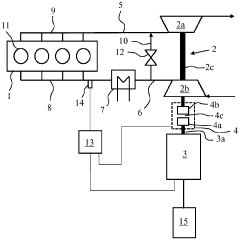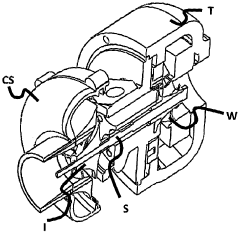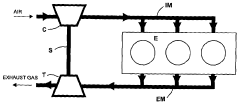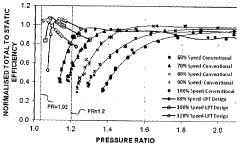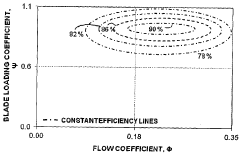How to Implement V8 Engine Turbocharging Successfully?
JUL 4, 20259 MIN READ
Generate Your Research Report Instantly with AI Agent
Patsnap Eureka helps you evaluate technical feasibility & market potential.
V8 Turbocharging Evolution and Objectives
The evolution of V8 engine turbocharging technology spans several decades, marked by continuous advancements in design, materials, and control systems. Initially introduced in the 1960s, turbocharging for V8 engines aimed to increase power output without significantly increasing engine size or weight. Early implementations faced challenges such as turbo lag and reliability issues, which drove subsequent innovations.
Throughout the 1970s and 1980s, turbocharging technology saw significant improvements in materials and design. The introduction of ceramic turbine wheels and advanced alloys enhanced durability and performance at high temperatures. Intercoolers became more prevalent, addressing the issue of charge air heating and further boosting engine efficiency.
The 1990s brought about a revolution in electronic engine management systems, allowing for more precise control of boost pressure and fuel injection. This era saw the widespread adoption of variable geometry turbochargers (VGT) in V8 applications, offering improved low-end torque and reduced lag. Dual turbocharger setups also gained popularity, particularly in high-performance and luxury vehicles.
As we entered the 21st century, the focus shifted towards combining turbocharging with direct fuel injection and variable valve timing. This synergy allowed for even greater power outputs while simultaneously improving fuel efficiency and emissions. The development of twin-scroll turbochargers further enhanced low-end response and overall efficiency.
Recent years have seen a trend towards downsized, turbocharged V8 engines as manufacturers strive to meet stringent emissions regulations while maintaining performance. Electric-assisted turbochargers and advanced wastegate designs have emerged as solutions to further reduce lag and improve transient response.
The current objectives for V8 turbocharging technology are multifaceted. Manufacturers aim to achieve higher specific power outputs while simultaneously reducing fuel consumption and emissions. There is a strong focus on improving transient response and eliminating perceptible turbo lag, bringing the driving experience closer to that of naturally aspirated engines.
Another key goal is to enhance the durability and reliability of turbocharged V8 engines, particularly in high-performance applications where thermal management is crucial. Integration with hybrid powertrains is becoming increasingly important, as manufacturers look to combine the benefits of turbocharging with electrification.
Looking ahead, the development of V8 turbocharging technology is likely to focus on further refinement of existing concepts and the integration of advanced materials and manufacturing techniques. The use of computational fluid dynamics and machine learning in turbocharger design is expected to yield more efficient and responsive systems, pushing the boundaries of what's possible with forced induction in V8 engines.
Throughout the 1970s and 1980s, turbocharging technology saw significant improvements in materials and design. The introduction of ceramic turbine wheels and advanced alloys enhanced durability and performance at high temperatures. Intercoolers became more prevalent, addressing the issue of charge air heating and further boosting engine efficiency.
The 1990s brought about a revolution in electronic engine management systems, allowing for more precise control of boost pressure and fuel injection. This era saw the widespread adoption of variable geometry turbochargers (VGT) in V8 applications, offering improved low-end torque and reduced lag. Dual turbocharger setups also gained popularity, particularly in high-performance and luxury vehicles.
As we entered the 21st century, the focus shifted towards combining turbocharging with direct fuel injection and variable valve timing. This synergy allowed for even greater power outputs while simultaneously improving fuel efficiency and emissions. The development of twin-scroll turbochargers further enhanced low-end response and overall efficiency.
Recent years have seen a trend towards downsized, turbocharged V8 engines as manufacturers strive to meet stringent emissions regulations while maintaining performance. Electric-assisted turbochargers and advanced wastegate designs have emerged as solutions to further reduce lag and improve transient response.
The current objectives for V8 turbocharging technology are multifaceted. Manufacturers aim to achieve higher specific power outputs while simultaneously reducing fuel consumption and emissions. There is a strong focus on improving transient response and eliminating perceptible turbo lag, bringing the driving experience closer to that of naturally aspirated engines.
Another key goal is to enhance the durability and reliability of turbocharged V8 engines, particularly in high-performance applications where thermal management is crucial. Integration with hybrid powertrains is becoming increasingly important, as manufacturers look to combine the benefits of turbocharging with electrification.
Looking ahead, the development of V8 turbocharging technology is likely to focus on further refinement of existing concepts and the integration of advanced materials and manufacturing techniques. The use of computational fluid dynamics and machine learning in turbocharger design is expected to yield more efficient and responsive systems, pushing the boundaries of what's possible with forced induction in V8 engines.
Market Analysis for Turbocharged V8 Engines
The market for turbocharged V8 engines has experienced significant growth in recent years, driven by the increasing demand for high-performance vehicles and the need for improved fuel efficiency. This segment primarily caters to luxury sports cars, high-end SUVs, and performance-oriented sedans, where power and prestige are paramount.
In the luxury sports car market, turbocharged V8 engines have become a staple, offering a balance between raw power and fuel economy. Brands like Ferrari, McLaren, and Porsche have embraced this technology, with their flagship models featuring turbocharged V8 powerplants. The market for these vehicles has shown steady growth, particularly in emerging economies where wealth accumulation has led to increased demand for luxury goods.
The high-end SUV segment has also seen a surge in the adoption of turbocharged V8 engines. As consumers seek vehicles that combine practicality with performance, manufacturers like BMW, Mercedes-Benz, and Range Rover have introduced turbocharged V8 options in their top-tier SUV models. This trend aligns with the global shift towards larger vehicles, especially in North America and China.
Performance sedans represent another key market for turbocharged V8 engines. Brands such as Audi, BMW, and Mercedes-AMG have incorporated these powerplants into their high-performance sedan lineups, catering to enthusiasts who desire sports car-like performance in a more practical package. This segment has shown resilience even in markets where environmental regulations are tightening, as manufacturers leverage turbocharging technology to meet emissions standards while maintaining performance.
The market analysis reveals a growing trend towards electrification, which poses both challenges and opportunities for turbocharged V8 engines. While some manufacturers are phasing out V8 engines in favor of smaller, turbocharged engines or hybrid powertrains, others are using turbocharging in conjunction with mild-hybrid systems to enhance performance and efficiency.
Geographically, North America remains the largest market for turbocharged V8 engines, followed by Europe and Asia-Pacific. The Middle East, with its preference for luxury and high-performance vehicles, also represents a significant market. However, stringent emissions regulations in Europe and parts of Asia are influencing market dynamics, pushing manufacturers to innovate and improve the efficiency of their turbocharged V8 offerings.
Looking ahead, the market for turbocharged V8 engines is expected to face challenges from the broader automotive industry's shift towards electrification. However, in the near to medium term, there remains a strong demand for these powerplants, particularly in niche segments where performance and brand heritage are crucial factors in purchasing decisions.
In the luxury sports car market, turbocharged V8 engines have become a staple, offering a balance between raw power and fuel economy. Brands like Ferrari, McLaren, and Porsche have embraced this technology, with their flagship models featuring turbocharged V8 powerplants. The market for these vehicles has shown steady growth, particularly in emerging economies where wealth accumulation has led to increased demand for luxury goods.
The high-end SUV segment has also seen a surge in the adoption of turbocharged V8 engines. As consumers seek vehicles that combine practicality with performance, manufacturers like BMW, Mercedes-Benz, and Range Rover have introduced turbocharged V8 options in their top-tier SUV models. This trend aligns with the global shift towards larger vehicles, especially in North America and China.
Performance sedans represent another key market for turbocharged V8 engines. Brands such as Audi, BMW, and Mercedes-AMG have incorporated these powerplants into their high-performance sedan lineups, catering to enthusiasts who desire sports car-like performance in a more practical package. This segment has shown resilience even in markets where environmental regulations are tightening, as manufacturers leverage turbocharging technology to meet emissions standards while maintaining performance.
The market analysis reveals a growing trend towards electrification, which poses both challenges and opportunities for turbocharged V8 engines. While some manufacturers are phasing out V8 engines in favor of smaller, turbocharged engines or hybrid powertrains, others are using turbocharging in conjunction with mild-hybrid systems to enhance performance and efficiency.
Geographically, North America remains the largest market for turbocharged V8 engines, followed by Europe and Asia-Pacific. The Middle East, with its preference for luxury and high-performance vehicles, also represents a significant market. However, stringent emissions regulations in Europe and parts of Asia are influencing market dynamics, pushing manufacturers to innovate and improve the efficiency of their turbocharged V8 offerings.
Looking ahead, the market for turbocharged V8 engines is expected to face challenges from the broader automotive industry's shift towards electrification. However, in the near to medium term, there remains a strong demand for these powerplants, particularly in niche segments where performance and brand heritage are crucial factors in purchasing decisions.
Current Challenges in V8 Turbocharging
Despite the widespread adoption of turbocharging in V8 engines, several significant challenges persist in achieving optimal performance and reliability. One of the primary issues is heat management. Turbochargers operate at extremely high temperatures, often exceeding 1,000°C, which can lead to thermal stress on components and potential failure if not properly managed. This challenge is particularly acute in V8 engines due to their compact design and high power output.
Another critical challenge is turbo lag, the delay between throttle input and the turbocharger's response. In V8 engines, which are often used in high-performance applications, minimizing this lag is crucial for maintaining the responsive feel expected from such powerplants. Engineers must balance the size and design of the turbocharger to provide both quick spooling at low RPMs and sufficient airflow at high RPMs.
Durability and longevity of turbocharger components also present ongoing challenges. The high-speed rotation of the turbine and compressor wheels, coupled with extreme temperature fluctuations, puts significant stress on bearings, seals, and other critical parts. Ensuring these components can withstand the demands of a V8 engine over extended periods is essential for reliability.
Packaging constraints pose another hurdle in V8 turbocharging. The addition of turbochargers, intercoolers, and associated plumbing to an already complex V8 engine layout requires careful design considerations. Engineers must find innovative ways to integrate these components without compromising engine bay packaging or vehicle aerodynamics.
Emissions compliance is an increasingly important challenge in turbocharging V8 engines. While turbocharging can improve fuel efficiency, it can also lead to increased NOx emissions due to higher combustion temperatures. Balancing performance gains with stringent emissions regulations requires sophisticated engine management systems and aftertreatment technologies.
Lastly, calibration and tuning present significant challenges in turbocharged V8 engines. Optimizing boost pressure, fuel delivery, and ignition timing across a wide range of operating conditions is a complex task. Engineers must develop robust calibration strategies that ensure smooth power delivery, fuel efficiency, and emissions compliance while maximizing performance potential.
Another critical challenge is turbo lag, the delay between throttle input and the turbocharger's response. In V8 engines, which are often used in high-performance applications, minimizing this lag is crucial for maintaining the responsive feel expected from such powerplants. Engineers must balance the size and design of the turbocharger to provide both quick spooling at low RPMs and sufficient airflow at high RPMs.
Durability and longevity of turbocharger components also present ongoing challenges. The high-speed rotation of the turbine and compressor wheels, coupled with extreme temperature fluctuations, puts significant stress on bearings, seals, and other critical parts. Ensuring these components can withstand the demands of a V8 engine over extended periods is essential for reliability.
Packaging constraints pose another hurdle in V8 turbocharging. The addition of turbochargers, intercoolers, and associated plumbing to an already complex V8 engine layout requires careful design considerations. Engineers must find innovative ways to integrate these components without compromising engine bay packaging or vehicle aerodynamics.
Emissions compliance is an increasingly important challenge in turbocharging V8 engines. While turbocharging can improve fuel efficiency, it can also lead to increased NOx emissions due to higher combustion temperatures. Balancing performance gains with stringent emissions regulations requires sophisticated engine management systems and aftertreatment technologies.
Lastly, calibration and tuning present significant challenges in turbocharged V8 engines. Optimizing boost pressure, fuel delivery, and ignition timing across a wide range of operating conditions is a complex task. Engineers must develop robust calibration strategies that ensure smooth power delivery, fuel efficiency, and emissions compliance while maximizing performance potential.
Existing V8 Turbocharging Solutions
01 Cylinder head design optimization
Improving the design of cylinder heads in V8 engines can significantly enhance performance. This includes optimizing the intake and exhaust ports, valve positioning, and combustion chamber shape to improve airflow and fuel mixture, resulting in better combustion efficiency and increased power output.- Cylinder configuration optimization: Optimizing the cylinder configuration in V8 engines can significantly improve performance. This includes adjusting the angle between cylinder banks, optimizing cylinder firing order, and implementing variable cylinder management systems. These modifications can enhance power output, fuel efficiency, and overall engine balance.
- Intake and exhaust system enhancements: Improving the intake and exhaust systems of V8 engines can boost performance. This involves designing more efficient air intake manifolds, implementing variable valve timing, and optimizing exhaust flow. These enhancements can increase horsepower, torque, and engine responsiveness across different RPM ranges.
- Fuel injection and combustion optimization: Enhancing fuel injection systems and optimizing combustion processes can significantly improve V8 engine performance. This includes implementing direct injection technology, adjusting fuel mixture ratios, and fine-tuning ignition timing. These improvements can lead to better fuel economy, increased power output, and reduced emissions.
- Turbocharging and supercharging systems: Implementing forced induction systems such as turbochargers or superchargers can dramatically increase V8 engine performance. These systems compress the intake air, allowing for more fuel to be burned and resulting in higher power output. Proper integration of these systems can significantly boost horsepower and torque across the engine's operating range.
- Engine management and electronic control: Advanced engine management systems and electronic controls play a crucial role in optimizing V8 engine performance. This includes implementing sophisticated ECU programming, adaptive learning algorithms, and real-time sensor feedback. These systems can fine-tune various engine parameters to maximize performance, efficiency, and reliability under different operating conditions.
02 Advanced fuel injection systems
Implementing advanced fuel injection systems in V8 engines can improve fuel atomization and distribution, leading to more efficient combustion. This can include direct injection technology, variable injection timing, and high-pressure fuel delivery systems, resulting in increased power, better fuel economy, and reduced emissions.Expand Specific Solutions03 Variable valve timing and lift
Incorporating variable valve timing and lift mechanisms in V8 engines allows for optimized valve operation across different engine speeds and loads. This technology can improve low-end torque, high-end power, and overall engine efficiency by adjusting valve timing and lift to suit various operating conditions.Expand Specific Solutions04 Turbocharging and supercharging
Implementing forced induction systems such as turbochargers or superchargers can significantly boost V8 engine performance. These systems increase the amount of air entering the combustion chambers, allowing for more fuel to be burned and resulting in higher power output and improved torque across the engine's rev range.Expand Specific Solutions05 Engine management system optimization
Enhancing the engine management system of V8 engines can lead to improved performance through more precise control of various engine parameters. This includes advanced electronic control units (ECUs), adaptive learning algorithms, and real-time sensor feedback to optimize fuel injection, ignition timing, and other critical factors for maximum efficiency and power output.Expand Specific Solutions
Key Players in V8 Turbocharging Industry
The implementation of V8 engine turbocharging is currently in a mature stage of industry development, with a significant market size and high technological maturity. Major players like BorgWarner, Garrett Motion, and Honeywell have established strong positions in this field. The market is characterized by intense competition among established automotive suppliers and OEMs such as Ford, Toyota, and GM. These companies are continuously innovating to improve turbocharger efficiency, reduce emissions, and enhance overall engine performance. The technology's maturity is evident in its widespread adoption across various vehicle segments, from passenger cars to heavy-duty trucks, with ongoing research focused on optimizing turbocharger designs for hybrid and electric powertrains.
Toyota Motor Corp.
Technical Solution: Toyota has developed a Dynamic Force Engine with integrated electric VVT-iE system for precise valve timing control. This system, combined with their D-4S direct and port fuel injection, allows for optimized turbocharging. They've implemented a single-scroll turbocharger with a ball-bearing-supported shaft for reduced friction and improved response[1]. Toyota's turbo implementation also features an advanced water-cooled intercooler integrated into the intake manifold for compact packaging and improved charge air cooling efficiency[2]. The engine management system utilizes adaptive learning algorithms to continuously optimize boost pressure and fuel injection timing based on driving conditions[3].
Strengths: Excellent fuel efficiency, reduced emissions, and improved low-end torque. Compact design suitable for various vehicle platforms. Weaknesses: Potentially higher production costs due to advanced technologies. May require more frequent maintenance for turbo components.
Honeywell International Technologies Ltd.
Technical Solution: Honeywell has pioneered advanced turbocharging technologies, including their TwoStage system for diesel engines. This system uses two turbochargers in series, with a smaller high-pressure turbo for low-end response and a larger low-pressure turbo for high-end power[4]. They've also developed electric compressor technology to eliminate turbo lag, which can be integrated with conventional turbochargers[5]. Honeywell's DualBoost aerodynamic design features a dual-sided compressor wheel, improving efficiency and transient response[6]. Their turbo bearings use advanced materials and coatings to reduce friction and improve durability under high temperatures and speeds[7].
Strengths: Industry-leading turbocharging efficiency, reduced turbo lag, and improved power density. Extensive experience in both gasoline and diesel applications. Weaknesses: Complex systems may lead to higher costs and potential reliability concerns in long-term use.
Core Innovations in V8 Turbocharging
Turbocharging arrangement and method for operating an internal combustion engine
PatentWO2012076751A1
Innovation
- A turbocharging arrangement featuring a turbocharger connected to a common shaft with an electric motor and an adjustable magnetic coupler, allowing stepless adjustment of torque between the motor and turbocharger, enabling rapid response to load increases and optimal charge pressure control without the need for a frequency controller, and allowing the electric motor to function as a generator.
A turbine wheel, a turbine and use thereof
PatentWO2012114058A1
Innovation
- A novel turbine wheel design with a specific area ratio of outlet to inlet area (A2/A1) less than approximately 0.4, combined with a shroud covering the wheel, and optimized exit relative flow angle between -41 degrees and -55 degrees, which allows for high performance at low pressure ratios by optimizing the geometry and flow conditions.
Emissions Regulations Impact
The implementation of V8 engine turbocharging is significantly influenced by emissions regulations, which have become increasingly stringent in recent years. These regulations aim to reduce harmful pollutants and greenhouse gas emissions from vehicles, pushing manufacturers to develop more efficient and cleaner engine technologies.
Turbocharging plays a crucial role in meeting these emissions standards while maintaining or improving engine performance. By increasing the air density in the combustion chamber, turbocharging allows for more efficient fuel burning, resulting in reduced emissions per unit of power output. However, the design and implementation of turbocharging systems must be carefully optimized to ensure compliance with emissions regulations.
One of the primary challenges in turbocharging V8 engines is managing NOx emissions. The higher combustion temperatures associated with turbocharging can lead to increased NOx formation. To address this, manufacturers have implemented various strategies, including exhaust gas recirculation (EGR) systems, which reduce combustion temperatures by recirculating a portion of the exhaust gases back into the intake manifold.
Particulate matter emissions are another concern, particularly with direct injection systems commonly used in modern turbocharged engines. To combat this, manufacturers have incorporated gasoline particulate filters (GPFs) into their exhaust systems, similar to those used in diesel engines.
The need to meet stringent CO2 emissions targets has also driven the development of more advanced turbocharging technologies. Variable geometry turbochargers and electric turbochargers are being explored to improve efficiency across a wider range of engine operating conditions, thereby reducing overall fuel consumption and CO2 emissions.
Emissions regulations have also influenced the materials and manufacturing processes used in turbocharger production. Heat-resistant alloys and advanced coatings are being employed to withstand the higher temperatures associated with more efficient combustion, while also meeting durability requirements set by emissions standards.
The impact of emissions regulations extends beyond the technical aspects of turbocharging implementation. Manufacturers must now consider the entire lifecycle emissions of their engines, including production and end-of-life recycling. This holistic approach has led to innovations in sustainable manufacturing practices and materials selection for turbocharger components.
As emissions standards continue to evolve, particularly with the shift towards electrification, the role of turbocharging in V8 engines may change. Hybrid powertrains incorporating turbocharged V8 engines are being developed to meet both performance demands and emissions requirements, highlighting the ongoing importance of turbocharging technology in the face of regulatory pressures.
Turbocharging plays a crucial role in meeting these emissions standards while maintaining or improving engine performance. By increasing the air density in the combustion chamber, turbocharging allows for more efficient fuel burning, resulting in reduced emissions per unit of power output. However, the design and implementation of turbocharging systems must be carefully optimized to ensure compliance with emissions regulations.
One of the primary challenges in turbocharging V8 engines is managing NOx emissions. The higher combustion temperatures associated with turbocharging can lead to increased NOx formation. To address this, manufacturers have implemented various strategies, including exhaust gas recirculation (EGR) systems, which reduce combustion temperatures by recirculating a portion of the exhaust gases back into the intake manifold.
Particulate matter emissions are another concern, particularly with direct injection systems commonly used in modern turbocharged engines. To combat this, manufacturers have incorporated gasoline particulate filters (GPFs) into their exhaust systems, similar to those used in diesel engines.
The need to meet stringent CO2 emissions targets has also driven the development of more advanced turbocharging technologies. Variable geometry turbochargers and electric turbochargers are being explored to improve efficiency across a wider range of engine operating conditions, thereby reducing overall fuel consumption and CO2 emissions.
Emissions regulations have also influenced the materials and manufacturing processes used in turbocharger production. Heat-resistant alloys and advanced coatings are being employed to withstand the higher temperatures associated with more efficient combustion, while also meeting durability requirements set by emissions standards.
The impact of emissions regulations extends beyond the technical aspects of turbocharging implementation. Manufacturers must now consider the entire lifecycle emissions of their engines, including production and end-of-life recycling. This holistic approach has led to innovations in sustainable manufacturing practices and materials selection for turbocharger components.
As emissions standards continue to evolve, particularly with the shift towards electrification, the role of turbocharging in V8 engines may change. Hybrid powertrains incorporating turbocharged V8 engines are being developed to meet both performance demands and emissions requirements, highlighting the ongoing importance of turbocharging technology in the face of regulatory pressures.
Cost-Benefit Analysis of V8 Turbocharging
Implementing V8 engine turbocharging involves significant costs and potential benefits that must be carefully evaluated. The initial investment in turbocharging technology can be substantial, including research and development, design modifications, and manufacturing process adjustments. However, these costs can be offset by the improved performance and efficiency gains achieved through turbocharging.
One of the primary benefits of V8 turbocharging is increased power output without a corresponding increase in engine size or weight. This allows manufacturers to meet stringent emissions regulations while maintaining or improving vehicle performance. The improved fuel efficiency resulting from turbocharging can lead to reduced operating costs for consumers and lower overall emissions, aligning with environmental goals and regulations.
However, the complexity of turbocharged systems can lead to increased maintenance costs and potential reliability issues. The additional heat generated by turbocharging requires more robust cooling systems, which can add to the overall cost and complexity of the engine. Furthermore, the increased stress on engine components may necessitate the use of more expensive materials or more frequent replacements, potentially increasing long-term ownership costs.
From a manufacturing perspective, the integration of turbocharging technology may require significant retooling and process changes in production facilities. While this represents a substantial upfront cost, it can lead to long-term efficiency gains and the ability to produce a wider range of engine configurations to meet diverse market demands.
Market analysis suggests that consumers are increasingly willing to pay a premium for vehicles with turbocharged engines due to their perceived performance benefits and improved fuel economy. This trend can justify the higher production costs associated with turbocharging technology, potentially leading to increased profit margins for manufacturers.
In terms of research and development, ongoing investment in turbocharging technology can yield innovations that further improve efficiency and performance. These advancements can provide a competitive edge in the automotive market and may lead to valuable patents and intellectual property.
Overall, the cost-benefit analysis of V8 turbocharging must consider both short-term expenses and long-term gains. While the initial costs are significant, the potential for improved performance, fuel efficiency, and market competitiveness can make turbocharging a worthwhile investment for many automotive manufacturers.
One of the primary benefits of V8 turbocharging is increased power output without a corresponding increase in engine size or weight. This allows manufacturers to meet stringent emissions regulations while maintaining or improving vehicle performance. The improved fuel efficiency resulting from turbocharging can lead to reduced operating costs for consumers and lower overall emissions, aligning with environmental goals and regulations.
However, the complexity of turbocharged systems can lead to increased maintenance costs and potential reliability issues. The additional heat generated by turbocharging requires more robust cooling systems, which can add to the overall cost and complexity of the engine. Furthermore, the increased stress on engine components may necessitate the use of more expensive materials or more frequent replacements, potentially increasing long-term ownership costs.
From a manufacturing perspective, the integration of turbocharging technology may require significant retooling and process changes in production facilities. While this represents a substantial upfront cost, it can lead to long-term efficiency gains and the ability to produce a wider range of engine configurations to meet diverse market demands.
Market analysis suggests that consumers are increasingly willing to pay a premium for vehicles with turbocharged engines due to their perceived performance benefits and improved fuel economy. This trend can justify the higher production costs associated with turbocharging technology, potentially leading to increased profit margins for manufacturers.
In terms of research and development, ongoing investment in turbocharging technology can yield innovations that further improve efficiency and performance. These advancements can provide a competitive edge in the automotive market and may lead to valuable patents and intellectual property.
Overall, the cost-benefit analysis of V8 turbocharging must consider both short-term expenses and long-term gains. While the initial costs are significant, the potential for improved performance, fuel efficiency, and market competitiveness can make turbocharging a worthwhile investment for many automotive manufacturers.
Unlock deeper insights with Patsnap Eureka Quick Research — get a full tech report to explore trends and direct your research. Try now!
Generate Your Research Report Instantly with AI Agent
Supercharge your innovation with Patsnap Eureka AI Agent Platform!
